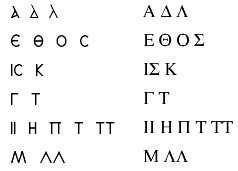Contents: Introduction * Table of Scripts Used in Various Uncials * Easily Confused Uncials (Greek and Latin) * Appendix: The Evolution of Writing Styles
In describing the script used Greek manuscripts, we speak of "uncial" and "minuscule" writing. But neither of these forms are fixed; both evolved over time. (Fortunately for us, else paleographers would have very little evidence to work with.) Indeed, late uncials show many features of the minuscule script, and many minuscules use uncial forms of at least certain letters.
The table below shows how uncials evolved over the centuries. Note how the clear, simple forms of early centuries could give way to very crabbed, difficult styles toward the end of the uncial era.
Note: Most uncials are rather small -- rarely more than a centimetre tall, and often much less. This means that it is difficult to reproduce them accurately on a computer screen. Although I worked hard to get reasonably clean scans (often enlarging the lettering for clarity), one should not consider the images below authoritative. For detailed paleographic work, refer to a manual on the subject.
The table below generally shows the most typical hand used for each manuscript -- e.g. the chart for Sinaiticus shows the hand of scribe A, who wrote all but a handful of the leaves of the New Testament.
Note: The above examples are intended to be printed at 72-75 dpi resolution, and the figures for sizes are based on that number.
As in most scripts, certain letters are easily confused in Greek uncials, and can sometimes give rise to errors. Some such examples are shown below (though each particular style of uncial will have its own examples), with the uncial form on the left and the modern form on the right:

In Latin, the following uncials are frequently confused (note that E, like the Greek
epsilon, was written in rounded form as an uncial):
I L T
F P R
C E O G U
EU COG
To understand the letterforms of a particular language, it is necessary to know the characteristics of the material it was written on. We noted above, for instance, the difference between the letterforms carved on the Rosetta Stone and the uncial script of the same general period: The engraved letterforms use almost entirely straight strokes.
Nonetheless it is clear that the Greek alphabet is originally a written (as opposed to a carved or inscribed) alphabet. This is in contrast to, for instance, the German runic alphabet, designed for inscriptions; its every stroke is straight.
Even more curious are the letterforms used in the Indian Ocean region (Sri Lanki, Burma). Books in those areas were written on palm leaves which had been cut to size and smoothed. Letters were inscribed with a stylus, and then (in at least some cases) inked.
Because the palm leaves were fragile and had a distinct grain, it was not possible, in the case of these writings, to use a horizontal stroke. Such a stroke would inevitably split the grain of the palm leaf, ruining the writing surface.
I have read that portions of the Quran were written on palm leaves also. But these portions were actually written, not inscribed, so the matter of stroke directions is somewhat less significant.
Other odd writing materials would have other effects. Certain important classical documents, e.g., were written on linen or woven cloth. Such cloth may not have a grain, but if it does, it will usually be easier to write horizontal and vertical strokes. And curves would be difficult on any woven material.
Cuneiform writing was not restricted so much by the writing material (clay will accept strokes in any direction) as by the stylus used to write it. You could, theoretically, draw almost anything in such a system, but it will be much slower.
All of these constraints have affected writing at one time or another. Imagine trying to inscribe the myriad symbols of Chinese writing in stone! The Chinese ideographic alphabet is possible only on surfaces which make writing possible. Surfaces which make writing difficult but make different strokes possible, on the other hand, encourage syllabaries, which use fewer strokes than alphabetic systems though they are somewhat harder to learn.
These concerns are not entirely trivial for students of New Testament writing and paleography. Papyrus was not as fragile as palm leaf, but it did have a very definite grain. This seems to be one reason why the codex was not popular for classical writings. A papyrus sheet consisted of two sets of strips pasted together. For reasons of strength, one set of strips would be set vertically, the other horizontally -- as a toy house today might be made with a double set of popsicle sticks, one half running vertically, the other horizontally. It was easy enough to write on the horizontal side -- indeed, that side of the sheet would not even need to be ruled. The vertical side was another matter. There were, of course, seams between the reeds of the vertical side; writing on these seams was difficult, but avoiding them was also problematic.
The roughness of the papyrus also had the effect of encouraging straight strokes. This was much less of a concern on vellum, which was nearly smooth and did not hinder curved strokes.